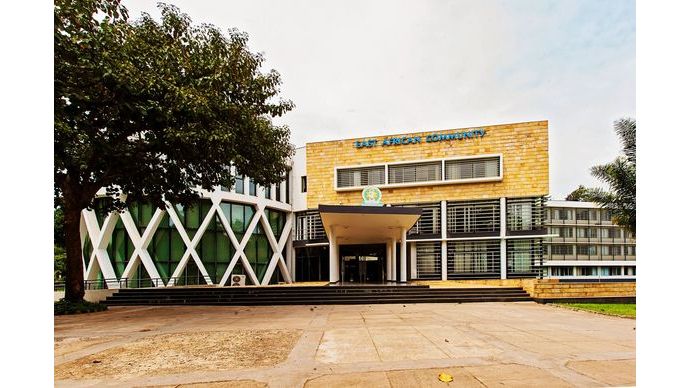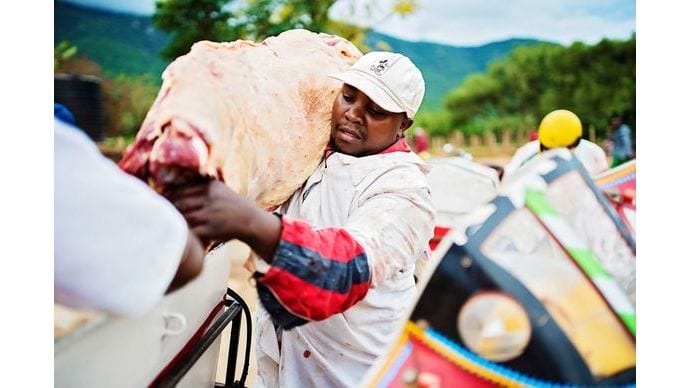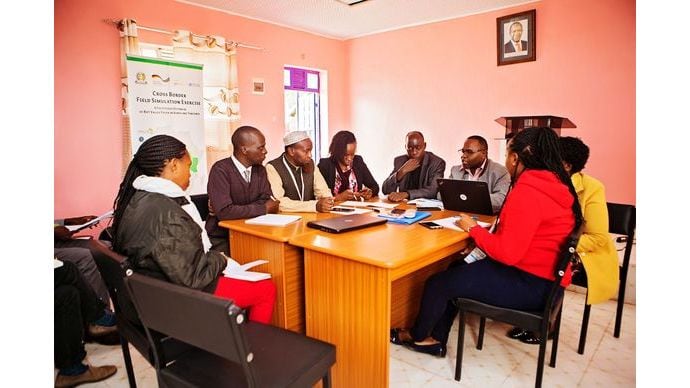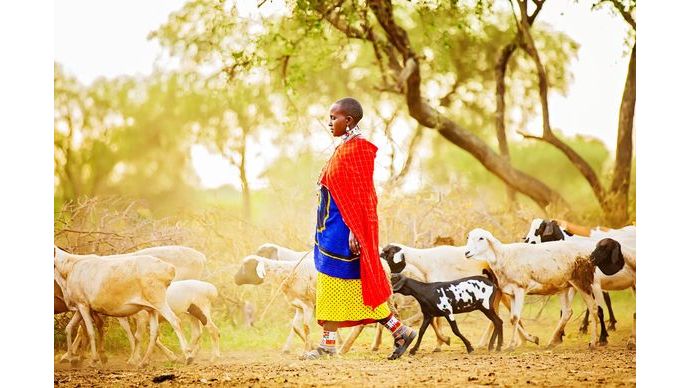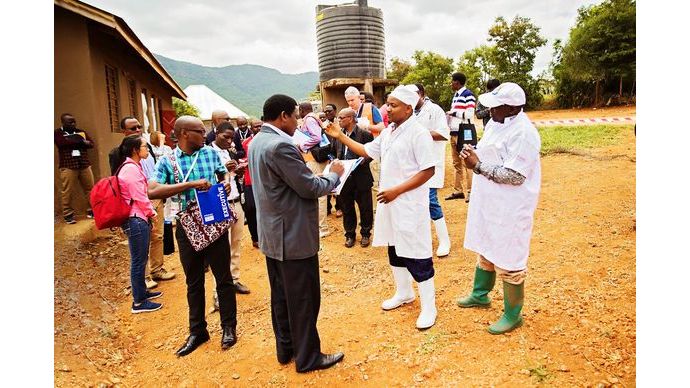Africa’s largest ever cross-border field simulation exercise tests the gaps in pandemic preparedness
After months of planning, almost 300 participants and observers took part in an ambitious cross-border Field Simulation Exercise on the Kenyan-Tanzanian border between 11th and 14th June 2019. This exercise, convened by the East African Community (EAC) Secretariat , was designed to test capacities for disease outbreak prevention and responses at a time when the region is on high alert against Ebola.
- Read the full report about the exercise.
Visit the photo gallery about the simulation exercise
As dusk gathers, the cows kick up clouds of dry, red dust as they make their way home to Parksanka boma, on the edge of Kenya’s Amboseli national park. Tall, young Moran wearing beads, red shukas (blankets) and rubber sandals made of tyre off-cuts supervise the herd as it makes its way into a kraal.
By local standards the head of the household, Jackson Ntipapa, with his 450 cows, 300 goats and 500 sheep, is a wealthy man. When pastures are bad, he drives his herds south across the nearby border to Tanzania, like generations of Maasai have done before him. For him the border is largely meaningless.
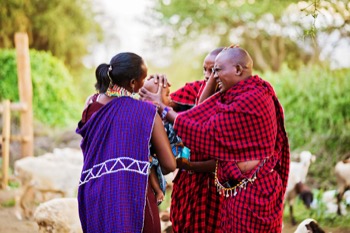
Today Ntipapa is worried: Some of his cattle appear to be sick, and he suspects they might have Rift Valley Fever (RVF), a mosquito-borne disease that is endemic in the area during the rainy season and can have devastating effects on ruminants and also infect humans. As he’s examining the cows, his wife also brings a child who has been complaining of a headache and fever. They decide to report the sick animals to the veterinary centre in Namanga, the nearest town that straddles the Kenya/Tanzania border, and his wife will take the child to the health centre. Fortunately, this scenario was not real, but just a part of the four-day Field Simulation Exercise in which Ntipapa and his family acted as key players. The FSX was held on both sides of the border between Kenya and Tanzania.
Viruses do not need visas
The scenario being tested during the exercise mimicked an outbreak of RVF, which infects animals and humans. The virus will soon evolve into a new pathogen that – unlike RVF – also spreads from human to human. The exercise is designed to test preparedness and responses not just for RVF, but for any outbreak of an infectious disease of public health concern. Just like Ntipapa’s cows, viruses don’t need visas to cross borders, so it is vital that countries in the East African Community region are alert and prepared and know how to respond to infectious diseases emergencies.
The exercise was very timely and extremely important. East Africa is on high alert for Ebola, as well as other infectious diseases such as Yellow Fever, Marburg, Crimean Congo and Rift Valley Haemorrhagic Fevers. The Democratic Republic of Congo (DRC) is currently struggling to contain the second ever largest outbreak of Ebola, which has already claimed more than 1,600 lives. Many more have been infected and there is a real threat that the epidemic could spread rapidly across porous borders to neighbouring countries.
Preparing for a new phase of high impact epidemics
The EAC Secretariat convened the simulation exercise, with assistance from the German Government through the “Support to Pandemic Preparedness in the EAC Region” Project that the Deutsche Gesellschaft für Internationale Zusammenarbeit (GIZ) GmbH implements in the EAC region. The World Health Organization’s Country Preparedness and International Health Regulations (IHR) Department had the technical lead in the exercise.
‘The EAC wanted to hold this field simulation exercise to assess the preparedness in the region for any potential outbreak, which could quickly spread across the region and across borders. We also wanted to test our Regional Contingency Plan and Regional Risk and Crisis Communication Strategy and Standard Operating Procedures to see where the gaps are,’ said Dr Michael Katende, Acting Head of the EAC Secretariat’s Health Department.
The FSX was the culmination of months of planning, following a decision taken by the EAC’s Sectoral Council of Ministers of Health in March 2015. This included a preparatory Table Top Exercise in September 2018 in Arusha, and setting up a Steering Group and Exercise Management Group to support the design and implementation of the FSX. ‘We are all convinced that the preparation process has been as important as the exercise itself,’ says Dr Irene Lukassowitz, leader of the EAC-GIZ PanPrep (Pandemic Preparedness) Project.
Implementing a ‘One Health’ approach
The exercise was designed to test the ‘One Health’ multi-disciplinary and multi-sectoral disease management approach which recognises that any outbreak scenario goes far beyond public health and can affect the economy, environment, trade, tourism, agriculture, communities and the media. These sectors can also contribute to preventing it and to mitigating its impact, so the FSX involved participants from a variety of disciplines and sectors, including – for the first time in a simulation of this sort – the military. Also for the first time, risk and crisis communication was applied as an important instrument in disease prevention and response.
Almost 300 people took part in the exercise, including participants from Kenya and Tanzania and observers from the EAC Partner States Burundi, Rwanda, South Sudan and Uganda as well as from Southern Africa. Participants from 16 regional and international organisations also took part in or observed the exercise. This gave an added opportunity for testing coordination and cooperation between regional and international organisations in an emergency.
The FSX focused primarily on the Namanga border crossing between Kenya and Tanzania, a main point of entry for people, animals and goods. It also involved local, national and regional administrations, the international airports in Nairobi and Kilimanjaro and the innovative mobile laboratories, provided to all EAC Partner States with support from the German Development Bank KfW and the Bernhard-Nocht-Institute for Tropical Medicine whose role in the exercise is described in this article.
Coordinating a complex operation

Situated in a room at the One Stop Border Post on the Kenyan side of the border, the Exercise Control Room was the planning and coordination hub for the exercise. Charts and aerial photographs lined the walls. They depicted the sites across Kenya and Tanzania participating in the FSX, including the Emergency Operations Centres (EOC) of the EAC Secretariat temporarily set up at the One Stop Border Post in Namanga, the regional and national Public Health EOCs in Dodoma, Nairobi and Arusha, the district EOCs in Longido (Tanzania) and Kajiado (Kenya) and the two international airports.
‘This is the biggest and most complex exercise WHO has ever coordinated,’ said Frederik Copper, WHO’s Exercise Coordinator. ‘We are working at 23 different locations over four days – mostly in a 20-30 km radius of the border at Namanga. So, logistics will be fundamental to the smooth running of the FSX and successful outcomes.’
Communications were another challenge, with limited Wi-Fi and mobile phone coverage, so before and during the exercise WHO consultant Denis Charles was busy charging back-up walky-talkies and pagers and setting up communications networks between the Control Room and exercise locations. All email correspondence from different participants – clearly labelled as an ‘exercise’ drill to avoid any possible confusion – were copied to the Control Room and displayed on an overhead projector so that they could be logged and evaluated.
The FSX took place in full view of the public, so it was important that the public was informed about the simulation in English and Kiswahili well ahead of the exercise. PanPrep briefed the national and local media and produced bi-lingual posters and banners explaining the purpose of the exercise. Leaflets were also handed out to all people crossing the border and communities made aware of the simulation to avoid any misunderstanding or panic.
Responding to crisis scenarios

The ‘script’ of the FSX scenarios, compiled during weeks of work by WHO consultant Allan Bell and the members of the Steering Group and the Exercise Management Group, was complex, and increased in complexity as the exercise progressed. Before and during each exercise scenario, participants received information and messages (known as ‘injects’) from the exercise control/facilitators and were expected to respond in line with their own policies and procedures. These injects included written information bulletins, phone calls and emails and actors playing a specific role (e.g. sick patients). Participants were expected to react and communicate as they would in a real-life setting and as part of their normal work procedures and responsibilities using existing contingency plans, SOPs and equipment.
Each exercise location had a facilitator, evaluator and observer and, for the purposes of the exercise participants were also asked to communicate their activities to the facilitators at each location at every turn, so that these could then be recorded and evaluated. Most of the exercise scenarios were replicated on both sides of the border, both to test local and national responses and the communication and collaboration between the two countries. These scenarios will be described in full in the ‘Lessons Learned’ report that is currently being prepared and will be shared on this page as soon as it has been published.
One of the liveliest scenarios of the simulation took place at the customs area on the Kenyan side of the One Stop Border Post at Namanga, when Maasai herdsman Jackson Ntipapa and some of his family tried to take seven goats from an infected area across the border in a pick-up truck. They were stopped by the police for not having the right paperwork. A ‘scuffle’ broke out as they tried to handcuff the Maasai. Ntipapa tried to run away, but he was caught by the police and ‘arrested’. The police then called the veterinary officers to come and check whether the goats are infected and Port Officers from both Kenya and Tanzania inspected the paperwork and their animals that were tested and put in quarantine for 14 days. The vets also called Nairobi for further advice, and the consignment had to return to Kenya.
Evaluating the exercise

WHO and the Exercise Management Group that planned the FSX systematically evaluated the exercise – from the strengths and weaknesses of pandemic preparedness it revealed to the way it was organised – during and immediately after the simulated scenarios, analysing feedback from facilitators, participants, observers and assessors.
Their main observations can be briefly summarised as follows:
- Both Kenya and Tanzania and the EAC Secretariat had contingency plans in place with respective Standard Operating Procedures;
- Both countries were able to activate their EOCs and Rapid Response Teams;
- Multi-sectoral and multi-disciplinary cooperation was good during the exercise;
- Both countries were able to follow WHO’s International Health Regulation guidelines;
- Local communities on both sides of the border demonstrated a high level of commitment, participation and support.
Among the key challenges were:
- Contingency plans and SOPs were not available at all levels;
- Not all existing SOPs had been approved;
- Infection control was insufficient, especially at the local and district levels;
- There were no clear communication channels between the different levels of rapid response teams;
- Logistics were a challenge at all levels;
- All Emergency Operations Centres were poorly equipped to deal with an outbreak;
- Neither human resources nor finances were sufficient.
Dr Lukassowitz said that although the FSX largely focused on a fictitious RVF outbreak, the lessons learned from the exercise scenarios are applicable to other diseases too. ‘What we tested was the capacity of people to respond and implement contingency plans. We hope the participants will continue to work together, close the gaps and apply what they have learned.’
The start of a process
The observations listed above suggest there is much work still to be done to strengthen the region’s contingency plans and SOPs. Dr Michael Katende of the EAC Secretariat says the EAC is committed to taking on board the lessons learned from the FSX and adopting the recommendations made by the participants: ‘This FSX was the beginning of a process, not the end.’
Ministers have already instructed the EAC Secretariat to conduct another cross-border field simulation exercise between the Republics of South Sudan and Uganda and this is scheduled for 2020.
Ruth Evans, July 2019
Further information on the FSX is available on the EAC website.


